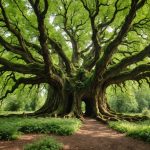Government Initiatives for Ancient Tree Protection
Ancient trees are vital assets that demand protection through dedicated government policies. In recent years, numerous policies have been implemented to preserve these natural treasures. Notable among these is the ancient tree legislation that aims to safeguard not only the trees themselves but also the biodiversity they support. This legislation is integral to forestry conservation efforts and enhances habitat quality by addressing ecological complexities.
Key Policies and Legislative Measures
Government conservation initiatives have emphasized strategic approaches to protect ancient trees. These include heightening awareness of their ecological significance and enforcing regulations to prevent illegal felling. Additionally, such initiatives often collaborate with local communities and conservation groups to ensure sustained environmental stewardship.
In parallel : Revitalize your garden: the ultimate guide for uk homeowners to create a wildlife-friendly paradise with native plants
Funding for Preservation Programs
Allocating funds for conservation initiatives is crucial. Government budgets often earmark resources specifically for ancient tree preservation programs, ensuring the necessary financial backing to maintain and monitor their health. These funds are utilized to train conservationists, conduct scientific research, and develop educational campaigns to engage the public in conservation efforts.
By integrating these elements, government initiatives work towards a holistic approach to ancient tree conservation, balancing ecological integrity with socio-economic benefits. Through robust government policies, we can secure the future of these irreplaceable natural heritages.
This might interest you : Enhancing biodiversity: creative hedgerow strategies for sustainable farming in the uk
Conservation Strategies Employed
Understanding the conservation strategies used to protect ancient trees is crucial for preserving biodiversity. These majestic trees are vital components of ecosystems, providing habitats for numerous species. Key strategies involve habitat restoration and tailored preservation techniques.
Examination of Conservation Techniques
Numerous techniques are employed to ensure the longevity of these ancient wonders. One effective approach is the careful monitoring of tree health. By assessing factors such as growth rates and pest presence, conservationists can make informed decisions on necessary interventions.
Role of Habitat Restoration
Habitat restoration plays a significant role in these efforts. Restoring the surrounding area can enhance the conditions for ancient trees to thrive. For example, removing invasive species allows native plants, which support the trees’ ecosystems, to flourish.
Collaborative Efforts Among Organizations
Collaborative efforts are essential in implementing successful conservation strategies. Organizations across various sectors join forces to share resources and expertise. Such collaboration can lead to the development of innovative preservation techniques, ensuring comprehensive protection efforts.
These combined actions highlight the importance of strategic planning and cooperation in safeguarding the future of ancient trees.
Community Involvement in Preservation
Community involvement plays a critical role in the preservation of ancient trees through grassroots initiatives and various community engagement programs. By taking part in these efforts, communities help ensure that these natural treasures continue to thrive for future generations.
Across the globe, numerous grassroots initiatives have successfully advocated for protecting ancient trees. One notable example is the Save Our Oaks campaign in the UK. This initiative mobilized local communities to preserve oak trees threatened by urban development. Through dedicated community engagement, residents rallied together, demonstrating the power of collective action. Their success not only protected the trees but also raised awareness about the importance of ecological conservation.
Incorporating dedicated volunteer programs into tree preservation efforts has proven to be invaluable. These programs often involve activities such as organizing tree planting events, conducting educational workshops, and monitoring tree health. By participating, volunteers gain a deeper understanding of the ecological significance of ancient trees and develop a sense of responsibility toward their protection.
Thus, involving communities in preservation efforts creates a shared sense of stewardship, enhancing conservation impacts. Whether through grassroots initiatives or structured volunteer programs, community participation is essential in safeguarding the legacy of ancient trees.
Case Studies of Successful Preservation Efforts
Successful preservation projects have resulted in significant environmental benefits and serve as models for future initiatives. One impactful project is the Ancient Trees Foundation, which focuses on the conservation of historic trees in urban areas. Through careful planning and community engagement, they’ve enhanced biodiversity and provided educational opportunities.
An impact assessment of these preservation projects reveals notable improvements in local ecosystems. For example, the restoration of a centuries-old oak forest in the United Kingdom resulted in increased species diversity and resilience against climate change. Another successful case study involves the preservation of redwood groves in California, where strategic management has sustained wildlife habitats and improved air quality.
Lessons learned from these projects are invaluable. The importance of community involvement cannot be overstated; local support ensures the longevity of preservation efforts. Additionally, integrating scientific research into project planning has proven effective, enhancing understanding of ancient trees’ ecological roles.
In summary, these successful case studies highlight the importance of preserving ancient trees and offer valuable insights for future projects. Their impact assessments demonstrate tangible environmental benefits, reinforcing the necessity of continued efforts in tree preservation.
Statistical Data on Ancient Tree Populations
Ancient trees are a significant component of biodiversity, offering unique insights into ecological health. A thorough statistical analysis reveals some fascinating trends about these venerable organisms in the UK. The recent data indicates a slow, yet worrying decline in their numbers over the past 50 years. This decline is critical; ancient trees play a pivotal role in maintaining local ecosystems, acting as a hub for various species.
Key Statistics
- The UK conserves approximately 115,000 documented ancient trees.
- Alarmingly, an annual reduction rate of about 1% persists in their populations.
- These trees support over 300 assorted species, underscoring their ecological significance.
Biodiversity Metrics
Ancient tree biodiversity metrics emphasize their importance in ecological studies. They provide unique habitats, fostering species that are often exclusive to their environment. Moreover, ancient trees act as crucial indicators of environmental changes. For instance, fluctuations in local biodiversity metrics can reflect broader ecosystem health challenges. This data helps conservationists devise strategies to safeguard these rare biomes.
Understanding these figures helps underscore the urgency of preserving ancient trees through evidence-based conservation efforts. In the face of environmental fluctuations, continued statistical analysis is essential to monitor trends and inform policies which protect these vital natural resources.
Expert Opinions and Insights
The importance of ancient tree conservation cannot be overstated, as expert insights consistently highlight their critical role in supporting biodiversity. Ancient trees provide habitats for numerous species, some of which are exclusively dependent on these venerable giants for survival. This underscores the ecological perspectives championed by conservationists, who view these trees as crucial to maintaining balanced ecosystems.
From ecological perspectives, ancient trees serve as carbon sinks, reducing greenhouse gases and helping stabilize the climate. They are reservoirs of genetic diversity, crucial for resilience against diseases and climatic changes. Such insights emphasize the need for strategies that integrate these trees into broader conservation efforts, ensuring their protection not only benefits the environment but also human societies dependent on biodiversity.
Despite this awareness, conservationists face multiple challenges. Urban expansion, agricultural development, and climate change contribute to habitat loss, threatening ancient tree populations. Navigating these threats requires a multi-faceted approach, balancing conservation with human development needs. Ensuring long-term conservation success, thus, calls for collaborative strategies involving government policies, community engagement, and scientific research. These efforts can leverage expert insights to overcome obstacles, ensuring ancient trees continue to thrive and support ecological diversity.
Future Challenges and Considerations
In the realm of ancient tree preservation, identifying potential future challenges is crucial. Conservation concerns are myriad, with the looming threat of climate change impacting tree species’ survival and distribution. As temperature and precipitation patterns shift, some ancient tree species may face habitats that are no longer hospitable, prompting the need for updated preservation strategies.
The climate impact on these ecosystems is profound. The ripple effects of increased frequency and intensity of storms, longer droughts, and altered seasons can’t be overlooked. These can lead to increased vulnerability to pests and diseases, which were previously held at bay by stable climates, thus exacerbating conservation efforts.
To address these concerns, policy adjustments are paramount. This includes strengthening protective legislation, enhancing monitoring systems, and fostering community involvement in conservation activities. Policies must also take into account the potential for genetic adaptation over time, ensuring a buffer against unforeseen environmental shifts.
Strategically, this requires a multi-faceted approach—one that integrates scientific research, advances in climate models, and active involvement from policymakers and conservationists, ensuring ancient trees endure these future challenges. Balancing ecological, social, and economic elements will be key in crafting successful solutions.











